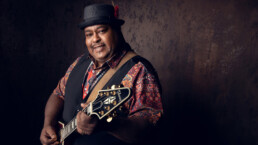Unleashing the Fretboard Fury: The Top 10 Guitar Solos of All Time
In the vast realm of music, few moments rival the electrifying thrill of a guitar solo. The marriage of technical prowess, emotional expression, and sheer musicality has given birth to some of the most iconic guitar solos in history. In this blog, we embark on a journey to explore and celebrate the top 10 guitar solos of all time, each a testament to the unparalleled skill and creativity of its guitarist.
RELATED: Practice your soloing techniques with JamPlay + TrueFire >
"Stairway to Heaven" - Led Zeppelin (Jimmy Page):
As the epitome of a classic rock solo, Jimmy Page's masterpiece in "Stairway to Heaven" is a timeless voyage of melodic beauty and dynamic expression. The solo's gradual build and crescendo have solidified its place in the pantheon of guitar greatness.
"Comfortably Numb" - Pink Floyd (David Gilmour):
David Gilmour's emotive solo in "Comfortably Numb" is a sonic marvel, weaving through the melancholy with exquisite phrasing and a mastery of tone. The solo's ability to convey raw emotion has made it a pinnacle of guitar artistry.
"Eruption" - Van Halen (Eddie Van Halen):
Eddie Van Halen's groundbreaking solo in "Eruption" redefined the possibilities of guitar technique. Frenetic tapping, dazzling speed, and unmatched innovation make this solo a cornerstone in the evolution of rock guitar.
"Hotel California" - Eagles (Joe Walsh & Don Felder):
The dual guitar solo in "Hotel California" is a harmonious dance of intricate melodies, courtesy of Joe Walsh and Don Felder. Its unmistakable allure has made it an enduring symbol of 70s rock sophistication.
"While My Guitar Gently Weeps" - The Beatles (Eric Clapton):
Eric Clapton's guest appearance on George Harrison's "While My Guitar Gently Weeps" resulted in a soul-stirring solo. Clapton's blues-infused phrasing adds a layer of depth to an already poignant composition.
"Sultans of Swing" - Dire Straits (Mark Knopfler):
Mark Knopfler's fingerstyle brilliance takes center stage in the solo of "Sultans of Swing." His unique picking technique and storytelling ability through the guitar make this solo an enduring classic.
"Free Bird" - Lynyrd Skynyrd (Allen Collins & Gary Rossington):
The triple guitar solo in "Free Bird" is a Southern rock anthem. Allen Collins and Gary Rossington's harmonized guitars contribute to the epic and free-spirited feel of the song, making it a standout in the rock canon.
"Little Wing" - Jimi Hendrix:
Jimi Hendrix's "Little Wing" is a guitar sonnet, showcasing his unparalleled ability to convey emotion through the instrument. The delicate intricacies of the solo make it a timeless gem in the world of guitar solos.
"November Rain" - Guns N' Roses (Slash):
Slash's soaring solo in "November Rain" is a testament to his melodic ingenuity. With a perfect blend of technicality and emotion, this solo has become an integral part of rock history.
"Time" - Pink Floyd (David Gilmour):
David Gilmour makes a second appearance on this list with his soul-stirring solo in "Time." The slow, bluesy bends and atmospheric tones contribute to the song's timeless beauty, showcasing Gilmour's versatility.
Conclusion:
These top 10 guitar solos stand as pillars of musical greatness, each a testament to the unique artistry and brilliance of its creator. From the soaring heights of "Stairway to Heaven" to the bluesy depths of "Little Wing," these solos have etched themselves into the fabric of music history, inspiring generations of guitarists and music enthusiasts alike. As we revisit these sonic masterpieces, we're reminded of the enduring power of the guitar solo to captivate, move, and transcend musical boundaries.
RELATED: Practice your soloing techniques with JamPlay + TrueFire >
As we bid farewell to the old and embrace the new, many of us find ourselves crafting New Year's resolutions in pursuit of personal growth and self-improvement. If you've always dreamed of learning to play the guitar, 2024 is your year to make that dream a reality. However, setting realistic goals is key to turning your musical aspirations into tangible achievements. In this blog, we'll explore how to set attainable objectives and embark on a fulfilling journey to master the guitar.
RELATED: Become a better guitar player with TrueFire All Access >
Assess Your Starting Point:
Before diving into the world of chords and melodies, take stock of your current musical knowledge and skills. Have you ever played an instrument before? Are you familiar with basic music theory? Understanding your starting point will help you set goals that are tailored to your individual needs and abilities.
Define Your Musical Style:
Guitar playing spans a wide range of genres, from classical to rock, blues to pop. Identify the style of music that resonates with you the most, as this will influence the techniques and skills you need to develop. Your goals should align with the specific demands of your chosen musical path.
Break Down the Learning Process:
Learning to play the guitar is a journey, not a destination. Break down the process into smaller, manageable steps. Set short-term goals that focus on fundamental aspects, such as mastering basic chords, understanding rhythm, and developing finger dexterity. Achieving these milestones will contribute to your overall progress.
Commit to Regular Practice:
Consistency is key when it comes to learning any skill, and playing the guitar is no exception. Set a realistic practice schedule based on your daily routine. Whether it's 15 minutes every day or an hour every other day, make sure your commitment aligns with your other responsibilities.
Utilize Online Resources and Courses:
In the digital age, a plethora of online resources and courses are available to guide aspiring guitarists. Consider enrolling in an online class, following instructional videos, or using interactive apps. These resources can provide structure to your learning and offer valuable insights from experienced instructors.
Join a Community:
Learning to play the guitar becomes more enjoyable and motivating when you're part of a community. Join online forums, social media groups, or local music communities where you can share your progress, seek advice, and connect with fellow guitar enthusiasts.
Embrace Setbacks and Celebrate Milestones:
Learning any new skill comes with its share of challenges. Understand that setbacks are a natural part of the learning process. Instead of getting discouraged, view them as opportunities to learn and grow. Celebrate small victories along the way, whether it's playing your first complete song or nailing a challenging chord transition.
Conclusion:
Embarking on a journey to learn the guitar in 2024 is a commendable and exciting endeavor. By setting realistic goals, embracing a structured approach, and staying committed to your practice, you'll find yourself strumming into the new year with newfound confidence and musical prowess. Here's to a year filled with beautiful melodies, personal growth, and the joy of making music!
RELATED: Become a better guitar player with TrueFire All Access >
December 28, 2023
Embarking on the journey of learning guitar online for beginners can be an exciting yet daunting experience. The digital realm offers a plethora of beginner guitar courses, and navigating through this vast sea can often feel overwhelming. This guide is dedicated to helping you find the best online guitar course that aligns with your musical aspirations and learning style.
RELATED: Learn the basics of Rock Guitar with Kevin Barry at TrueFire >
The Similarities Across Beginner Guitar Courses
Regardless of the genre - be it Blues, Jazz, Rock, Country, or Singer-Songwriter - the foundational elements of beginner guitar courses remain consistent. They all cover tuning the guitar, mastering basic open position chords, learning simple strumming patterns, and playing a few easy songs. The true differentiation in learning paths occurs once these basics are established, leading to more genre-specific skills and techniques.
While innovative learning tools like slow motion, looping, and fretboard animation enhance the experience, remember there’s no elusive "secret sauce" in teaching methods. The real game-changer is the connection you establish with the course content and its delivery.
The Crucial Role of Instructor Relatability
The cornerstone of your learning experience hinges on how well you connect with the instructor and the course material. Here’s how to embark on this crucial selection process:
1. Start with Research
Initiate your search by exploring highly-rated online guitar courses. Look for ones that boast positive testimonials and high rankings. These endorsements are indicators of quality and student satisfaction, albeit subjective.
2. Evaluate Instructors Through Samples
Nearly all top-rated courses offer free video introductions or sample lessons. Use these to assess the instructor's teaching style, communication skills, and overall appeal. Ask yourself:
Does the instructor have a welcoming and engaging online presence? Can you relate to their teaching approach and personality? Are they skilled in genres that interest you? Your instinctive reactions to these sample lessons are crucial in determining your potential connection with the instructor.
3. Narrow Down Your Options
Based on your impressions, start narrowing down your choices. Eliminate courses where the instructor, despite their accolades or positive reviews, doesn't resonate with you personally.
4. Consider Costs
While most beginners' courses are reasonably priced, payment models vary. Some offer subscription-based access, while others allow one-time purchases with downloadable content. Choose what aligns best with your budget and learning preference.
5. Consider Learning Tools
Assess the learning tools provided. Features like guitar tabs, slow motion, looping controls, and fretboard animations can significantly enhance your learning experience, especially for visual and hands-on learners.
Your Formula for Finding The Perfect Course For You
In conclusion, finding the perfect online beginner guitar course involves a balance of several factors:
- High Rankings + Positive Testimonials: Indicators of quality and student satisfaction.
- Genre Specialization: Ensures alignment with your musical interests.
- Instructor Relatability: Crucial for a personalized and engaging learning experience.
- Affordability: Aligns with your budget and preferences in course access.
- Effective Learning Tools: Enhances the overall learning experience.
By carefully considering each of these aspects, you're set to embark on an enriching and enjoyable guitar-learning journey. Remember, the right course is not just about learning chords and strums; it's about sparking a lifelong passion for music. Happy strumming!
RELATED: Learn the basics of Rock Guitar with Kevin Barry at TrueFire >
December 27, 2023
The Benefits of Playing Solo Guitar Pieces: 10 Tips for Learning How to Do It
The guitar is an incredibly versatile instrument, and there are countless ways to play it. Depending on your preferred style and musical interests, you may find yourself drawn to playing in bands or ensembles, where your role is to contribute to a larger musical landscape. However, there are also many benefits to learning to play solo guitar pieces. Whether you're a seasoned musician or just starting out, developing solo guitar skills can help you become a more well-rounded player.
In this post, we'll relate five good reasons you should consider learning to play solo guitar pieces and ten tips on getting started.
RELATED: Check out Rob Swift's NEW TrueFire Course, One Man Jam: Blues, Vol. 2 >
Solo guitar pieces can help you improve your technique. Playing solo guitar requires a high level of technical skill, as you need to be able to play both melody and rhythm simultaneously. Practicing solo pieces can help you improve your finger dexterity, hand coordination, and ability to execute advanced techniques like fingerpicking and arpeggios.
They offer a great opportunity to showcase your individual style. When you're playing in a band or ensemble, your role is often to blend in with the other musicians. On the other hand, playing solo guitar pieces allows you to express your unique musical voice and showcase your individual style.
They can be a great exercise in creativity. When you're playing solo guitar, you have complete control over the musical landscape. This freedom can be a great exercise in creativity, as it allows you to experiment with different chords, rhythms, and melodies to create a sound that's uniquely your own.
Solo guitar pieces can help you develop your musical ear. Playing solo guitar requires a heightened sense of musical awareness, as you need to be able to listen to both the melody and the harmony simultaneously. Practicing solo pieces can help you develop your ear for melody and harmony, improving your ability to learn and play other music.
They can be a great way to connect with other musicians. While solo guitar pieces may be played alone, they can also be a great way to connect with other musicians. Many guitarists enjoy playing and performing solo pieces together, and doing so can be a great way to build camaraderie and learn from others.
Now that we've explored some of the benefits of learning to play solo guitar pieces let's look at ten tips for getting started.
Start with simple pieces: If you're new to playing solo guitar, it's best to start with simple pieces focusing on basic techniques like fingerpicking and chord progressions. As you become more comfortable with these techniques, you can move on to more advanced pieces.
Practice regularly: Like any musical skill, playing solo guitar requires regular practice. You can set aside time each day to work on your solo pieces, even if it's just for a few minutes.
Break pieces down into sections: When you're learning a new solo piece, break it into smaller sections and work on each individually. Once you're comfortable with each section, could you assemble them to play the entire piece?
Use a metronome: Playing solo guitar requires a strong sense of rhythm. A metronome can help you stay on time and improve your rhythm skills.
Record yourself playing: Recording yourself playing your solo pieces can help you identify areas that need improvement and track your progress over time.
Take lessons from a guitar teacher: If you're starting out or struggling to improve, consider taking lessons from a guitar teacher who can provide personalized feedback and guidance.
Study the works of other solo guitarists: Listening to and studying the works of other solo guitarists can be a great way to learn new techniques and styles.
Experiment with different tunings: Playing in alternative tunings can help you discover new sounds and techniques you may have never thought possible.
Use dynamics to add interest: Varying the dynamics (volume and intensity) of your playing can add interest and emotion to your solo pieces.
Don't be afraid to make mistakes: Playing solo guitar takes time and practice, and it's okay to make mistakes along the way. Use your mistakes as opportunities to learn and improve.
Conclusion: Whether you're a seasoned guitarist or just starting out, learning to play solo guitar pieces can be a valuable and rewarding experience. By practicing regularly, breaking down pieces into sections, and experimenting with different techniques and styles, you can develop your solo guitar skills and become a more well-rounded musician. So why not give it a try today? Who knows? You might discover a new musical passion.
RELATED: Check out Rob Swift's NEW TrueFire Course, One Man Jam: Blues, Vol. 2 >
Equalization Techniques and Tips for Home Recording and Music Producers
Nothing can be more frustrating than a badly mixed track. You have all the elements in place, but it doesn't sound right. As a musician or music producer, you know that having a balanced mix is crucial. It’s the final stage of the music-making process that gives your music a professional touch. One of the most important tools you can use to achieve a balanced mix is equalization.
In this post, we’ll look at equalization techniques and tips to help you get your mixes to sound balanced and professional. Start with a clean slate. It's important to record your tracks before you start to EQ your tracks properly. Ensure they’re well balanced, the levels are set correctly, and there is no unwanted background noise. This gives you a clean slate to EQ your tracks.
RELATED: Get Vince DiPasquale's New Course, Science of Sound: Equalization >
Understand frequency ranges: Knowing and understanding the different ranges is key in EQ. Low frequencies are between 20Hz and 250Hz, mid frequencies are between 250Hz and 4kHz, and high frequencies are between 4kHz and 20kHz. Each frequency range has a distinct sound that can be used to shape your tracks.
Know what to cut and what to boost: One of the most important things to know when EQing is what to cut and what to boost. For example, if you’re working with a guitar track, you might want to cut the lower frequencies to reduce bass rumble or boost mid-range frequencies to make it sound more present.
Keep things subtle: It can be tempting to go crazy with EQ to make something stand out, but it’s best to keep things subtle. You don’t want to change a track drastically, as it can throw off the entire mix. Try making small adjustments and listening to how they affect the overall sound of the mix.
Use EQ in context: EQing in context means EQing your tracks in the context of the entire mix. You want to ensure that each track sounds good on its own but also fits well with the other instruments in the mix.
Use subtractive and additive EQ techniques: subtractive EQ means removing frequencies that don’t contribute to the overall sound, while additive EQ means boosting frequencies that contribute to the overall sound. Using a combination of both techniques can help you achieve a well-balanced mix.
Prioritize instruments: You want to ensure that your most important instrument is prioritized in the mix. For example, if you’re working on a vocal track, you’ll want to prioritize it over the other instruments in the mix and ensure it’s given enough space to shine.
Use EQ to fix problem areas: There will always be problem areas in a mix that need fixing. Whether it’s a harsh frequency or a muddy bass, using EQ can help you fix these problems and make your mix sound more professional.
Don’t overdo it: As mentioned before, it’s important to keep things subtle. Don’t overdo the EQ, or you’ll end up with an unnatural mix.
Check your mix in different environments: It’s important to check your mix in different environments, such as in your car, on headphones, or on speakers. This way, you can hear how the mix sounds in different contexts.
EQ is an essential tool for achieving a balanced mix. By understanding different frequency ranges, knowing what to cut and what to boost, using subtractive and additive EQ techniques, and keeping things subtle, you can achieve a professional-sounding mix that stands out. But remember, the key to achieving a balanced mix is to listen carefully and experiment.
You can play around with different EQ settings until you find what works for your tracks and always remember to check your mix in different environments.
RELATED: Get Vince DiPasquale's New Course, Science of Sound: Equalization >
The Art of Creating Flowing Guitar Solos
You may have started developing your soloing skills as a guitar player by building a vocabulary of licks and phrases to string together into a solo. While this is a great starting point, you may have noticed that your solos sound mechanical and unnatural. The missing ingredient is the art and creativity that go into crafting an expressive, flowing solo. This blog post will explore the techniques and mindset necessary to elevate your guitar solos to the next level.
RELATED: Get Tim Lerch's NEW TrueFire Course, BlueStream Soloing >
Understanding the Importance of Melody
The key to creating a memorable guitar solo is to focus on crafting a strong melody. The melody is the heart of the solo and should be the first thing you think about when you sit down to play. Keep your phrasing simple and easy to follow, and try to make each note count. It's not about playing as many notes as possible; it's about conveying emotion through a well-crafted melody. Listen to your favorite guitar solos and study how the melody evolves throughout the solo.
Add Dynamics and Variety
Another aspect of creating a flowing solo is adding dynamics and variety. This means playing with different volume, sustain, and intensity levels to create a journey that keeps the listener engaged—experiment with playing soft and then increasing your volume slowly as the solo builds. Use techniques like vibrato bends and slides to add expression and variety to your phrasing. Don't be afraid to take risks and try new things to keep your solos interesting.
Using Space and Restraint
One of the biggest mistakes guitar players make when crafting a solo is not leaving enough space in their playing. Embracing silence and intentionally leaving some gaps in your playing can be just as vital as the notes you play. This allows the listener to process and appreciate what has already been played, building up anticipation for the next phrase. Restraint can also add emotional depth to your playing and make your solos more memorable.
Building a Storyline
Creating a flowing solo is like telling a story. It should start simple and build tension before resolving to a satisfying conclusion. Think about your solo's beginning, middle, and end and how you want to make your listeners feel throughout the journey. This means varying your dynamics, tempo, and phrasing to keep your solo interesting and engaging. Always remember the overall arc of the solo and how you want to convey emotions through your phrasing.
Practice and Experimentation
The final step in creating flowing guitar solos is practice and experimentation. You won't develop your own style overnight, but by practicing regularly and experimenting with new techniques and approaches, you'll begin to discover what works for you. Don't be afraid to make mistakes or try things that don't immediately sound great. Sometimes, the most interesting solos are born out of experimentation. Keep an open mind and be persistent, and you'll discover your own unique voice as a guitar player.
Creating expressive and flowing guitar solos requires a different mindset and approach than simply stringing together a list of licks. You should prioritize the melody of the solo and use dynamics, variety, and space to create interest and emotion. By building a storyline and consistently practicing and experimenting, you can create memorable and personal solos. Always remember to keep an open mind and be persistent, and you'll continue to grow and develop as a guitar player.
RELATED: Get Tim Lerch's NEW TrueFire Course, BlueStream Soloing >
Larry McCray: The Bluesman Who Carries The Torch of Tradition
It's not every day that you get the chance to learn from someone who has shared a stage with the legends of the blues genre. Larry McCray, a Rust Belt blues singer, guitarist, and bandleader, has played alongside some of the biggest names in the business, such as B.B. King, Buddy Guy, and Albert King, to name a few.
RELATED: Get Larry McCray's NEW Course, Bridging The Blues, on TrueFire >
His ability to blend traditional blues with his soulful spin sets Larry apart from other bluesmen. He has been recognized with several awards for his playing, including the Orville H. Gibson Male Blues Guitarist of the Year and the Top Guitarist prize in the International Blues Matters writer's poll. This blog post explores how Larry McCray emulates great gospel singers with vibrato, slides, and string bending in his solos and how he develops a solid right-hand attack by mixing fingertips and picking.
Larry McCray believes that the blues is like a well-traveled road where one honors the old footprints and stamps out their own unique path. He starts every lesson with a reminder of the importance of honoring the roots of the blues. His playing style is a testament to his dedication to this philosophy, as Larry has a way of blending traditional blues with his own unique style, making it feel fresh and modern.
One of the most striking aspects of Larry's playing is his use of vibrato, slides, and string bending in his solos. He often goes back to his gospel roots for inspiration in his lessons. He believes gospel singers have an unmatched ability to infuse soulful vibrato into their singing, and he tries to emulate that in his guitar solos. Larry's slides and string bends give his solos a distinct character, which is always soulful and groovy.
Larry's lessons also focus on developing a strong right-hand attack. He believes the right-hand technique is as important as the left-hand technique in guitar playing. In his lessons, Larry mixes the use of fingertips and picking to create a distinct tone that separates him from other blues guitarists. He also stresses the importance of rhythm, pointing out that the groove is the backbone of the blues.
When it comes to developing interesting chord progressions, Larry keeps it simple. He uses smaller chord fragments to spice up the progressions. He also emphasizes the importance of using lick-enhancing techniques to create a more interesting and varied sound.
In Larry's latest album, he showcases his rhythm and lead guitar mastery. In his lessons, Larry offers insights into how he crafted his solos and rhythm parts for some of the tracks in the album. He also shares tips for making the most of what you already know, emphasizing that even small changes to your playing can significantly impact the overall sound.
Aspiring guitarists will gain a wealth of knowledge from Larry McCray's lessons. His ability to blend traditional blues with his unique style is awe-inspiring. He offers an incredible insight into his playing style, from picking techniques to chord progressions and solo crafting. His approach to the blues is refreshingly modern, yet he is always mindful of the genre's roots. Larry McCray is, without a doubt, the modern-day torchbearer of the blues tradition.
RELATED: Get Larry McCray's NEW Course, Bridging The Blues, on TrueFire >
Whether you're a beginner strumming your first chords or a seasoned guitarist shredding through complex solos, one element remains fundamental to your musical journey: guitar scales. Guitar playing is a timeless art that transcends genres, styles, and skill levels. In this blog, we'll explore the significance of guitar scales and why they are indispensable, regardless of your experience level.
RELATED: Check out TrueFire's Guitar Scales Chart >
Foundation of Musical Understanding:
Guitar scales serve as the building blocks of music theory. By learning and understanding scales, players gain insight into the fundamental principles of melody, harmony, and rhythm. This knowledge lays a solid foundation, enabling you to navigate the fretboard with confidence and creativity.
Enhanced Finger Dexterity with Guitar Scales:
Practicing guitar scales enhances finger dexterity and agility. The repetitive patterns within scales help develop muscle memory, allowing your fingers to move effortlessly across the fretboard. This improved dexterity not only facilitates smoother playing but also opens the door to more advanced techniques and intricate musical expressions.
Improvisation and Creativity in Guitar Scales:
Mastery of guitar scales empowers players to improvise and express their unique musical voice. As you become familiar with different scales, you'll discover the art of combining notes to create your own solos and melodies. This creative freedom is not exclusive to advanced players; even beginners can experiment with basic scales to add a personal touch to their playing.
Understanding Chord Progressions:
Guitar scales and chord progressions are closely intertwined. Knowing scales allows you to identify and understand the underlying structure of chord progressions. This knowledge is crucial for creating harmonically rich compositions and improvisations, enabling you to play with confidence in various musical settings.
Guitar Scales Across Genres:
Whether you're a rock enthusiast, a blues aficionado, or a jazz aficionado, guitar scales are your passport to versatility. Different genres often rely on specific scales, and by expanding your scale repertoire, you broaden your musical palette. This versatility enables you to explore and appreciate a wide range of musical styles, fostering a deeper connection with the instrument.
Technical Proficiency and Speed:
As you delve into scales, you'll inevitably enhance your technical proficiency. Scales demand precision, control, and speed, pushing your playing abilities to new heights. This technical development is essential for executing complex passages, solos, and challenging musical arrangements.
Conclusion:
In the vast landscape of guitar playing, mastering scales is a journey worth undertaking, regardless of your experience level. From beginners laying the groundwork for their musical education to seasoned players seeking to push the boundaries of their creativity, guitar scales are the keys to unlocking a world of musical possibilities. Embrace the scales, explore their nuances, and watch as your playing transforms into a harmonious expression of your unique musical identity.
RELATED: Check out TrueFire's Guitar Scales Chart >
December 18, 2023
Are you a musician who is doing home recordings and struggling to get your mix right? Then worry no more! This article will discuss important practices and bus processing - this can help you polish your tracks and achieve a professional-sounding mix.
Two integral aspects of mixing are bus processing and general mixing practice, which we will explore in detail. Whether you’re a seasoned home recording musician or just starting, by the end of this article, you’ll better understand how to achieve a cohesive and polished mix.
RELATED: Get Jono Buchanan's NEW Science of Sound Course all about Bus Processing >
Bus Processing:
As the name suggests, bus processing refers to processing multiple tracks together as a group rather than treating them individually. This method helps to create a cohesive sound and adds glue and warmth to the mix.
The main advantage of bus processing is that it saves valuable time when dealing with multiple tracks.
Here are a few tips on using bus processing:
1. Group tracks with a similar role, such as drums, bass, guitars, and vocals. This way, you can apply processing to the entire group, and everything will be affected uniformly.
2. Use EQ to create more space for each instrument. For example, apply a high-pass filter to the bass track, thus leaving space for the kick drums.
3. Compress the group to add cohesion to the mix.
4. Use reverb or delays to create depth and dimension.
General Mixing Practice:
General mixing practice refers to the techniques used to create a balanced and clean mix. Here are a few essential practices that you can use to achieve this:
1. Start by setting the levels of every track in your mix. Ensure it's well balanced, and no track is too loud or soft.
2. Use EQ to clean up any unnecessary frequencies and ensure that each instrument has a unique space in your mix, as EQ helps create a perfect balance in your mix.
3. Use compression to make your mix come together. Compression helps to even out the volume and add a bit more punch to your mix.
4. Pan your tracks to give them a place in the stereo field. Make sure all your instruments aren't piled up in the center, but take advantage of the stereo field to create width.
5. Use automation to add more movement to your mix.
In conclusion, bus processing and general mixing practice are essential techniques to take your home recordings to the next level. Being creative and daring with mixing always pays off in terms of creating a unique and pleasant listening experience for your audience.
If you are a musician doing home recordings, the above techniques will help you improve your mixes and ultimately achieve a professional sound. So, dive into bus processing and general mixing practice and bring out the best of your music. Happy mixing!
RELATED: Get Jono Buchanan's NEW Science of Sound Course all about Bus Processing >
December 15, 2023
As a guitar player, have you ever struggled to develop interesting and creative solos during improvisation? Whether you're playing blues, rock, jazz, or any other style, the pentatonic scale is a valuable tool that can help take your improvisation to the next level. In this blog post, we'll explore the power of the pentatonic scale and how you can use it to create amazing solos in any style on the guitar.
RELATED: Check out Jeffery Marshall's new TrueFire Course, Pentatonic Hijacks >
What is the pentatonic scale?
The pentatonic scale is a musical scale that contains five notes per octave. In Western music, there are two commonly used pentatonic scales: the major and minor pentatonic scales. The major pentatonic scale consists of the 1st, 2nd, 3rd, 5th, and 6th degrees of the major scale, while the minor pentatonic scale consists of the 1st, b3rd, 4th, 5th, and b7th degrees of the natural minor scale.
Why is it so powerful?
The pentatonic scale is powerful because the notes in the scale are very "safe"—in other words, they sound good when played together. This makes creating interesting and melodic solos much easier, especially when you're just starting out with improvisation. Additionally, the pentatonic scale is used in various musical styles, from blues to rock to country to jazz, so learning it will enable you to play in many different contexts.
How can you use it in improvisation?
There are many ways to use the pentatonic scale in improvisation. One simple technique is to use the scale to create licks or phrases that you can play over chord progressions. For example, you could use the minor pentatonic scale to create a bluesy solo over a 12-bar blues progression.
Another technique combines the pentatonic scale with other scales or modes to create more complex and interesting solos. For example, you could use the Dorian mode (a minor mode with a raised 6th) and the minor pentatonic scale to create a more sophisticated sound.
How can you practice the Pentatonic Scale?
There are many ways to practice the pentatonic scale. One simple exercise is to play the scale up and down the fretboard in different positions. Another exercise is to practice playing the scale in different rhythms or patterns. Using the pentatonic scale, you could also try improvising over backing tracks in different musical styles. The key is practicing regularly and experimenting with the scale in different contexts.
How can you take your improvisation to the next level?
Once you've mastered the pentatonic scale, there are many ways to take your improvisation to the next level. One approach is to learn other scales and modes and to practice combining them with the pentatonic scale. Another approach is to study other guitar players' solos and analyze their use of scales and techniques. You could also experiment with different effects and pedals to create unique and interesting sounds.
The pentatonic scale is a powerful tool every guitar player should use in their improvisation toolkit. By understanding the basics of the scale and practicing regularly, you can create amazing solos in any style on the guitar.
RELATED: Check out Jeffery Marshall's new TrueFire Course, Pentatonic Hijacks >
December 14, 2023










